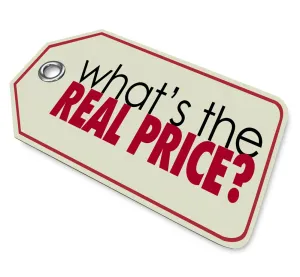Truth in pricing is a common issue when discussing the sale of a business.
The selling price of their company is a point of pride for any owner. When they are willing to share the price they were paid, they usually include everything that was listed in the purchase agreement. While there is nothing inherently dishonest about that, it’s often not exactly the truth either.
In our last article we saw Bob, the owner of Bob’s Widgets, came to the conclusion that he needed to sell his business for $6,000,000 in order to replace his current salary and the Seller’s Discretionary Earnings (SDE) such as the vehicle and health insurance that his business pays for.
He knows that his friend Edgar sold his widget company for $5,000,000. Both Bob and Edgar have about 40 employees. Bob thinks his newer manufacturing equipment allows him to operate more efficiently than Edgar. Edgar freely discloses that his revenues were $4,000,000 in the year prior to the sale. Bob’s sales were $7,000,000 last year.
We will ignore Bob’s EBITDA ($500,000) for this exercise. Whether his expectations are practical as a multiple of profits is a discussion for another time.
Is it unreasonable to presume that if a $4,000,000 revenue company in the same industry can sell for $5,000,000, then a $7,000,000 company should sell for $6,000,000? Bob figures that he is not only being reasonable, but perhaps he is shooting too low.
Truth in Pricing
To begin, let’s see what Edgar’s price consisted of.
Royalty payments on specialty widgets that Edgar patented were value at around $150,000 a year for the next ten years. That was $1,500,000 of his “selling price.” In addition, although Edgar’s equipment was old, it was paid for. His company was debt-free. He generated almost $1,000,000 in EBITDA annually.
truth in pricingEdgar’s buyer also wanted him to stick around for three years. Edgar calculated his salary of $150,000 a year as part of the “purchase price.” He also had an “earn out” of $500,000 a year for reaching certain sales goals in the next two years. In total, royalties, salary and conditional payments made up $2,950,000 of his $5,000,000 price, leaving only a bit more than $2,000,000 as “cash on the barrelhead.”
Did Edgar lie? Not in his own eyes. Given some time, effort and luck., he will eventually realize $5,000,000 in total pre-tax income related to his business. It’s his version fo truth in pricing.
Bob’s Price
First Bob has to consider what his price would include. He has about $350,000 left on the lease/purchase of his two newest widget manufacturing machines, which would have to be paid off by the buyer. He also owes about $300,000 on his revolving credit line.
Bob has always felt that vacation pay is earned, and never bothered to put a limit on its accrual by employees. He would be shocked to learn that his 40 employees, who average about $50,000 in salary, have about 240 weeks of unused vacation time. That’s another $230,000 plus the employer’s payroll taxes. Let’s call it a quarter million dollars. Edgar had a maximum one-week carryover. His liability was about $40,000. If Bob’s buyer is willing to pay a five (5x) multiple of EBITDA, the unrecognized vacation expense could drop the purchase price by nearly $1,000,000.
Bob is also anticipating a stock sale, with a tax burden of about $1,200,000 on his sale price. If it’s an asset sale (90% of small businesses are asset sales), he can expect that number to be much higher. In short, even if Bob could demand $6,000,000, his actual cash price might be more than a million and a half dollars less, and his tax burden almost a million dollars more. Suddenly Bob has the equivalent (in his eyes) of a $3,500,000 sale.
Closing the Value Gap
Welcome to the second part of the Value Gap. Now Bob realizes that not only will he need substantially more money to fund his post-exit lifestyle, but his company can’t currently provide the level of proceeds he was planning on for retirement.
It may seem surprising, but the answer to this problem for many owners is “I’ll just work longer.” The challenge of closing the Value Gap is too daunting to wrap their thinking around.
Some planning could help Bob. He can modify his benefit structures and pay off some debt, but let’s say that his $6,000,000 price is reasonable, and growing the value to $8,000,000 would meet his goals. Breaking that down on an annual basis renders a growth target of less than 6% annually over the next 5 years.
That may be a better solution than “just keep working.” Bob’s time frame may be longer or shorter. He may modify his target income. He may be able to economize in his business operations to increase cash flow. There are a number of options to consider, but they all require that Bob first understands his Value Gap and truth in pricing.
John F. Dini develops transition and succession strategies that allow business owners to exit their companies on their own schedule, with the proceeds they seek and complete control over the process. He takes a coaching approach to client engagements, focusing on helping owners of companies with $1M to $250M in revenue achieve both their desired lifestyles and legacies.




